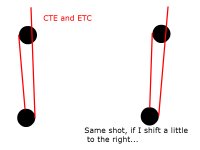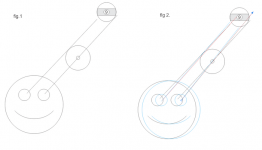Sorry to bring up an old thread, but it has some valuable information.
I have been searching for an explaination on how to Use CTE/Pro one, and stumbled here. I have not bought the DVDs yet, but will soon, as this system looks very promising
I have learned alot with this thread, and this (above quoted) helped some, but I have a hard time bringing that to the table. From your explaination, we are from the cue ball's perspective, so obviously, if I move my head, I lose that visual. I made a quick diagram of what I see, and what others have said they see.
If I stand behind the cue ball, I can visualise both lines. In this example, if I shift a little to the right, I can still see both lines clearly. Where do I set myself to then drop in full stance and do the pivot / sweep?
In your example, I would have to get my visuals just over the cue ball, at table's height, which is very different than getting them standing up above both balls.
If I'm wrong in anything, and if you confirm the DVD2 will explain all of this, I'll buy, but in the meantime, I'm very curious on how you see it.

